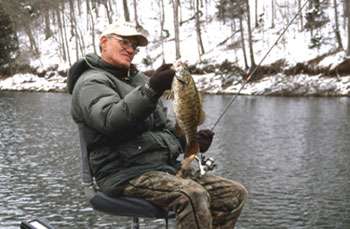
Blade baits are the second major category of heavy metal baits. Unlike jigging spoons, however, blade baits are not generally used to catch schooling bass. They're at their best when used against scattered bass.
No one really knows who designed, or first fished with, blade baits. But we do know who perfected them — Buddy Banks, with the help and advice of legendary smallmouth angler Billy Westmorland. Together they designed and marketed the Silver Buddy. And after generations of use it's still the standard to which all other blade baits aspire.
"It's one of the best lures around for cold water bass. And note I said bass, not smallmouth bass. Sure, it'll catch smallies but it's death on largemouths and spots too," says renowned Dale Hollow Lake angler Cobby Hayes. "I use one just about anytime the water temperature drops below 55-60 degrees. Once the shad start dying from the cold there isn't anything better."
Hayes' theory is that some bass school in cold weather but not all of them. His six decades on the water have led him to believe that many bass — especially the true giants — roam about the lake as the water cools feeding on dying shad.
"You can catch a lot of bass in schools during the winter. But the true trophies, the ones that you brag about all your life, will be found by themselves," he says.
Hayes fishes his blade baits in the traditional manner. He'll typically move along a steep, rocky bank making casts directly towards the shoreline. Once the bait is on the bottom he lifts it up about 18 inches and then lets it flutter down to the bottom again. The idea is to mimic a dying shad, struggling for its life.
"The biggest bass are solitary creatures. They live and feed alone, especially in late winter and early spring. Now's the time to catch one, but you've got to keep moving and cover a lot of water, he explains. "It's not like looking for a school. Your electronics won't find one bass very efficiently. You need to fish steep, 45 degree rocky banks if they're available in your reservoir. If not, fish anywhere there are shad, some deep water and a steep drop in the substrate."
Hayes also believes that size is overrated; vibration and flutter speed are more important. He's convinced that if the vibration on the upswing is too fast, too slow, too hard, or too soft it'll run the fish off rather than call them in. And, if the flutter is off the bass will become wary of the bait and shy away from it.
"The idea is to attract them on the upswing and make them bite on the flutter. Vibration is important, but the flutter on the fall is the most important. Shad don't drop straight but they don't swing back and forth like a hammock either. They drop more or less straight with some twisting and jerking on the way down. Think of it this way — they don't want to fall to the bottom but they can't help it.
"I like the 1/2-ounce Silver Buddy best, but that's not because of its size or weight. It's because of the way it vibrates and falls. They're hard to find now, so if you're looking for a replacement keep those two things in mind," he says emphatically. "They're the most important."




